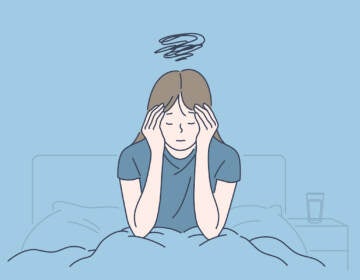Reclaiming a good night’s sleep after trauma-induced insomnia
Listen 3:52
Vashti DuBois stands over her bed. (Kimberly Paynter/WHYY)
A museum exhibit helped Vashti DuBois finally sleep after nearly 3 years of unrest.
Standing in her living room — a serene, dark space filled with antique wood furniture and the sweet musk of incense — Vashti DuBois picks her way through a shelf of artifacts that she calls “prescriptions.”
There are candles, herbal teas, a container of empty Benadryl packets — and Jack Daniels.
“I’m not a drinker but, you know, I always say I don’t judge,” says DuBois, hefting the glass bottle of whiskey from the shelf. “I feel like people should figure out what they need to do to get sleep.”
It’s all part of “A Good Night’s Sleep,” the latest exhibition at The Colored Girls Museum, which DuBois runs out of her charmingly well-worn Victorian home in northwest Philadelphia.
Almost every room of her house doubles as an exhibition space for the show, which DuBois describes this way: “A discovery by the colored girl of what’s keeping her awake at night, and what might we prescribe to help her get sleep.”
It’s a topic that she knows well. That’s because for much of the past three years, DuBois, 56, has been dealing with chronic insomnia — ever since her husband was killed in a car accident.
“I came to understand, which was part of the inspiration for the show, that the trauma was keeping me awake,” she says. “Even things like the rain, since it was a rainy night when he had his car accident.”
After her husband’s death, DuBois says she began sleeping less and less. She’d drift off late at night only to wake up a few hours later. In the predawn darkness, she’d wander from room to room, feeling the emptiness of the house.
As her sleepless nights multiplied, DuBois’ exhaustion grew.
“I was so tired, I would be laughing about nothing,” she remembers. “A lot of the feeling was just like, please God just let me sleep. I really just want to sleep.”
Soon, the lack of sleep began to affect her. DuBois says she began to lose the ability to focus, control her moods, and filter information from the outside world. Her teenage son helped draw DuBois’ attention to that fact.
“His responses to me, I think, are what really made me begin to notice the impact intellectually,” DuBois says. She was frustrated with her growing irritability and absentmindedness.
DuBois’ doctors offered her prescription-strength sleep aids, but she was reluctant.
“I knew that this was part of the grieving process and I didn’t want to short-circuit it or medicate it,” she says. “I really wanted to go through it.”
Instead, she started researching strategies for battling insomnia. One of the first things she did was transform her bedroom into a sleep-only space, removing all electronics and making a rule that the room could only be used for sleeping and a few other limited purposes.
DuBois also began rethinking how she prepared for bed.
“I’m a theater person, so I’m always thinking about, what are the practices that allow your body to get ready for something?” she says.
DuBois began surrounding herself with rituals. She bought new nightclothes, and downloaded an app that reminded her when it was time to get ready for bed. In the evenings, she started drawing the curtains, lighting candles and bathing before settling down for the night.
“I credit some of that with doing the show, because thinking about it and talking about it really sort of made me responsible for trying to imagine what different things I might do to help myself go to sleep,” she says.
Finally, after two and a half years of sleepless nights and hazy days, DuBois began sleeping again. These days, despite the stresses of running the Colored Girls Museum, along with finances, motherhood and everything else, DuBois tries to prioritize a good night’s sleep.
“I feel like that’s really that’s one of the biggest gifts I can give myself,” she says. “And I have a great appreciation for it now because I didn’t have it for a long time.”
WHYY is your source for fact-based, in-depth journalism and information. As a nonprofit organization, we rely on financial support from readers like you. Please give today.







